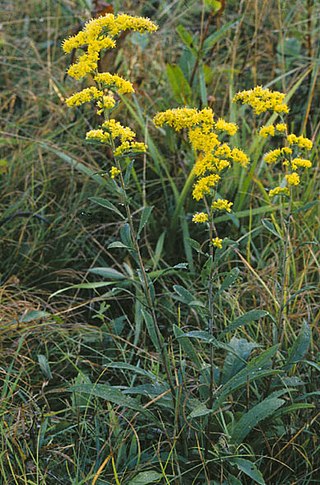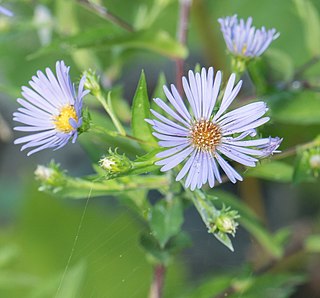
Andrew Michael Spence is a Canadian-American economist and Nobel laureate.

Goldenrod is a common name for many species of flowering plants in the sunflower family, Asteraceae, commonly in reference to the genus Solidago.
The Flora of North America North of Mexico is a multivolume work describing the native plants and naturalized plants of North America, including the United States, Canada, St. Pierre and Miquelon, and Greenland. It includes bryophytes and vascular plants. All taxa are described and included in dichotomous keys, distributions of all species and infraspecific taxa are mapped, and about 20% of species are illustrated with line drawings prepared specifically for FNA. It is expected to fill 30 volumes when completed and will be the first work to treat all of the known flora north of Mexico; in 2015 it was expected that the series would conclude in 2017. Twenty-nine of the volumes have been published as of 2022.

Heliopsis is a genus of herbaceous flowering plants in the family Asteraceae, native to dry prairies in North and South America. The sunflower-like composite flowerheads are usually yellow, up to 8 cm (3 in) in diameter, and are borne in summer. Species are commonly called ox-eye or oxeye.

Symphyotrichum puniceum, is a species of flowering plant in the family Asteraceae native to eastern North America. It is commonly known as purplestem aster, red-stalk aster, red-stemmed aster, red-stem aster, and swamp aster. It also has been called early purple aster, cocash, swanweed, and meadow scabish.

Bryaceae is a family of mosses.

Corylus americana, the American hazelnut or American hazel, is a species of deciduous shrub in the genus Corylus, native to the eastern and central United States and extreme southern parts of eastern and central Canada.

Artemisia campestris is a common and widespread species of plants in the sunflower family, Asteraceae. It is native to a wide region of Eurasia and North America. Common names include field wormwood, beach wormwood, northern wormwood, Breckland wormwood, boreal wormwood, Canadian wormwood, field sagewort and field mugwort.

Pediocactus knowltonii is a rare species of cactus known by the common names Knowlton's miniature cactus, Knowlton's pincushion cactus, and Knowlton's minute cactus.

Bryum is a genus of mosses in the family Bryaceae. It was considered the largest genus of mosses, in terms of the number of species, until it was split into three separate genera in a 2005 publication. As of 2013, the classification of both Bryum and the family Bryaceae to which it belongs underwent significant changes based on DNA studies.
Rubus setosus, the bristly blackberry, is a North American species of flowering plant in the rose family. It is widespread in much of central and eastern Canada and the northeastern and north-central United States

Hypericum prolificum, known as shrubby St. John's wort, is a deciduous shrub in the genus Hypericum. It was named for its "prolific" number of stamens.

Hypericum gymnanthum, the small-flowered St. John's wort or clasping leaf St. John's wort, is a species of flowering plant in the St. John's wort family Hypericaceae native to wet woods, bogs, and ditches of the eastern United States and Guatemala. It has been introduced to Poland.

Hypericum fasciculatum, known as peelbark St. Johnswort or sandweed, is a species of flowering plant in the St. Johnswort family, Hypericaceae, native to the southeastern United States. It is found from eastern North Carolina, south to southern Florida, west to eastern Louisiana. Kew's Plants of the World Online database also notes that it occurs in Cuba, though Cuba is not listed in several other sources. It was first described in 1797 by Jean-Baptiste Lamarck.

Ptychostomum turbinatum, also known as topshape thread-moss or pear-fruited bryum, is a species of moss found in continental Europe and the US. The species became extinct across the British Isles in the 1940s according to the Species Recovery Trust and in 2001 according to the IUCN, and it has not reestablished since.

Ptychostomum pseudotriquetrum, commonly known as marsh bryum, is a species of moss belonging to the family Bryaceae. Bryum pseudotriquetrum is a synonym. The species has cosmopolitan distribution.
Ptychostomum cyclophyllum, round-leaved bryum, is a species of moss belonging to the family Bryaceae.

Ptychostomum schleicheri, the Schleicher's bryum moss, is a species of moss belonging to the family Bryaceae. The leaves' color ranges from yellow to yellow-copper.

Ptychostomum is a genus of mosses belonging to the family Bryaceae. It has an almost cosmopolitan distribution. It has two subgenera, Psychostomum (Ptychostomum) and Psychostomum (Cladodium).
Geraldine Anne Allen is a botanist, professor of biology, and herbarium curator at the University of Victoria in British Columbia, Canada. She obtained formal education at the University of British Columbia and Oregon State University, earning a Doctor of Philosophy degree in botany and plant pathology from the latter in 1981. During her career, she has authored or co-authored over 50 publications, including genera chapters for Flora of North America and the Jepson Manual. She also has authored several species of the Erythronium genus.















